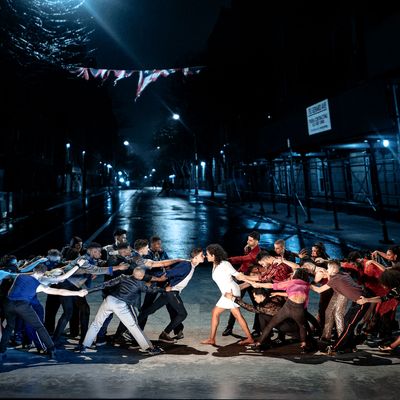
There’s a rumble on Broadway right now, and — just as with those poor unfortunate Jets and Sharks — nobody’s winning. The tussle is happening right in the middle of West Side Story, where the Belgian director Ivo van Hove’s revival has been mortally divided against itself, done to death by its own staging and design choices.
Dominated by an IMAX-size projection wall showing all manner of video — a live feed of actors on- or backstage, pre-shot film of New York streets at night — the production seems perversely gifted at finding the exact mode that will interfere with each moment and intention. There are certainly a few fine elements in the show, and Maria (Shereen Pimentel) and Tony (Isaac Powell) — clear, sweet-voiced, unaffected — do their iconic parts proud. Powell’s superb Tony vibrates with energy and puppyish optimism; his rendition of “Maria” is revelatory, a show-and-heart-stopper. If Pimentel’s Maria seems less able to escape the show’s occasional sabotage, her soprano is keenly lovely, a silvery fretwork above the rest of the ensemble’s brassy, swaggering noise.
But when this West Side Story wants to be gritty, van Hove’s sexy-wexy backdrop choices make it cheesy and anodyne; when a performer tries to be genuine, some awkward live zoom will reveal artificiality. Attention, both the audience’s and the performers’, is critically divided. Few people on earth can emote in close-up for the camera and reality’s “wide shot” simultaneously; it’s an actor’s nightmare. This gives the experience an odd, juddering quality: the knowledge that we’re always, somehow, watching someone good at their worst.
To be clear, this isn’t a blanket condemnation of fixing something that wasn’t broke. Of course it’s understandable that a director would encounter this material and want to rebel. There’s the challenge of its terrifying parentage: composed by Leonard Bernstein, written by Arthur Laurents and Stephen Sondheim, shaped by Jerome Robbins. In musical-theater terms, that’s all our daddies in one place, and the content is pure teenage fury. Van Hove clearly feels that up-yours-grandpa impulse; you can sense him resisting every old success of the original project. For more than 60 years, productions have introduced the warring crews of West Side with Robbins’s running, jumping, and snapping. But in van Hove’s cut-down version, as the orchestra plays Bernstein’s propulsive Prologue, the Jets saunter into the bare cavern of the mammoth Broadway Theatre as cool as homicidal cucumbers. They stop along the edge of the unadorned stage, staring outward like suspects in a lineup. The Sharks stride out, glaring menacingly at us in their turn. Bernstein’s music runs and jumps and snaps up at them from the orchestra beneath their feet; the trumpets plead with them to move — but they stay defiantly still.
So we have plenty of time to size up the delinquents. Costume designer An D’Huys puts everyone in modern street clothes, if the term “street clothes” can stretch past hoodies to include bandeaus and sequined dance slacks and temporary face tattoos. (Call it elevated gang-leisure.) Soon, the enormous back wall fills with their images. A camera mounted on the balcony rail zooms in to show us 20-foot-high close-ups of the company, sneering and posing hard in high-def. Seen from the audience, they look so grim! But onscreen, they look … so pretty. The choreography of the long camera pan along their line turns the Jets and Sharks from toughs giving us a hard stare into models serving runway-ready stink eye. That’s the first gesture the video undermines; it won’t be the last.
Van Hove’s interpretation is Hobbesian: brutal and short. The lush 1957 Romeo-and-Juliet story has been tightened to an intermissionless hour and 45 minutes, and one of Sondheim’s least favorite songs, “I Feel Pretty,” has been chopped out entirely. Robbins’s choreography is gone, replaced by the Belgian postmodernist Anne Teresa De Keersmaeker’s work, though her contribution is actually a surprisingly conventional mélange of styles. The musical itself forces her hand: If people sing about mambo-ing, then they’re gonna have to mambo.
Even though this show has been freaking out critics since the beginning, the new team has decided to (further?) emphasize the show’s savagery. The already vile “taunting” of Maria’s friend Anita (Yesenia Ayala, a profoundly effective actor and astounding dancer) has been translated into an unambiguous rape scene, caught in a hidden corner of the set by a voyeuristic camera. The racial makeup has changed — the Jets, written as a white gang, are now a diverse group led by a black Riff (Dharon E. Jones), sometimes deliberately making it difficult to tell the Jets and Sharks apart. The authority figures are all still white, though: Doc (Daniel Oreskes, affecting in tiny moments) is still the well-meaning Jewish pharmacist; Lieutenant Schrank (Thomas Jay Ryan) and Officer Krupke (Danny Wolohan) are still terrifying and unsympathetic portraits of white legal coercion. These attempts at political commentary rebound unflatteringly, since the show seems unsure how to handle explicit violence in a world where the fights are so dancey. The sly, vaudevillian “Gee, Officer Krupke” is already about police malfeasance, for instance, so putting a montage behind it of black people in handcuffs and a shrine to those cut down by cop bullets is somehow both embarrassingly on the nose and a grave tonal misfire.
And real-world trouble already touches the show. The protests continue — some on the streets outside the theater — over Amar Ramasar’s casting as gang leader Bernardo. Last year, Ramasar was one of the New York City Ballet dancers suspended and expelled for exchanging nude photographs of women in the company. After intervention by an arbitrator, he was reinstated. Producer Scott Rudin and van Hove have both been asked about the choice to cast Ramasar; both have expressed their full support. Van Hove has described the dancer as “acquitted,” which may mean he hasn’t understood the disciplinary actions taken by NYCB.
But Ramasar, once cast, actually needed a very different form of directorial support. West Side Story requires enormous things of its performers, and Ramasar’s singing voice is unsteady, his acting, rendered ludicrous by his stage–Puerto Rican accent, hammy. Among so many triple and double threats, even his balletic elegance — when he jumps it’s like a dolphin spinning — seems like a small offering. In Ramasar’s Broadway debut, Carousel, Jack O’Brien’s production heavily weighted his time onstage toward movement, bending to his strengths. Here, he’s one of many among the “America” dancers and lost in the scrum of the fight scenes, and De Keersmaeker never offers him a bravura sequence. In the plot, though, he’s the equivalent of Shakespeare’s Tybalt, the Prince of Sharks who needs to keep an entire Puerto Rican community together. Bernardo sets the tone: It’s a tough acting challenge. Van Hove leaves him exposed.
Which brings us back to that strange divided quality, that sense of a production fighting internally and leaving the actors to fend for themselves.
Van Hove’s austere aesthetic, devised by his brilliant longtime designer Jan Versweyveld, is leaner and more abstract than the typical Broadway look; he automatically modernizes everything he touches, from Shakespeare to O’Neill. He also has a way of intensifying and interpolating male sexuality in relatively tight-zippered American classics — as in his homoerotic A View From the Bridge, or his version of The Crucible that salivated over John Proctor’s bleeding back. Here, he gives Riff and Tony a lingering, nose-to-nose stare that makes us wonder how Riff sees Tony’s defection, and all the guys like to fight with their shirts off in a gigantic onstage rainstorm, because shirts are so confining.
So far, so good. But when van Hove introduces those video components, his control wavers and crashes. At his best, he’s a minimalist, skilled with compression and reduction. But even though he’s been working with projection for ages, the filmscapes in his shows are too frequently sloppy and unattractive. Here they are at their worst: aesthetically inchoate (they seem as if they’ve been made by a half-dozen different hands), and the entire stage composition has almost never been taken into account.
And what good do they do? A hefty percentage of the footage is in slow-mo, so we watch a 25-foot Tony walk moodily down a street in slow motion, or the Jets bro-ishly pummel one other in slow motion, or Bernardo put on a shirt … in slow motion. We don’t tend to see much of the women in these sequences, so they steer directly into a boy-band-music-video vibe. (Man, One Direction got serious.) Worse, though, are the live images. Onstage, actors sometimes shoot one another from unsteady iPhones, which makes a dizzying, distracting backdrop. And some interior scenes, like Doc’s pharmacy, are shot in completely realized sets that are either partly or completely obscured from the audience. Fixed cameras peep around corners; their transmissions have the flat look of soap-opera scenes, and they do no favors to the actors inside them.
So is it all trash? No. It’s self-defeating for long sections, but there’s enough promising material to wish that everyone could have just taken a year off and tried again. Sure, the screen utterly overpowers the stage while also feeling like an afterthought — but that makes the first decision easy. Switch off the projectors. The good moments are already the ones that don’t rely on video. The rumble in the rain is thrilling, for instance, and De Keersmaeker echoes other Romeo and Juliet ballets to stage a powerful non-balcony Balcony Scene, with Maria and Tony leaning like ships’ figureheads as their communities pull them apart. And instead of the traditional “Somewhere” ballet, van Hove has the ensemble sing the song together under deep orange sodium light, lovers everywhere dreaming of walking two-by-two. He generalizes the central pair’s plight out to the entire company. It’s in this simple “Somewhere” that van Hove touches the live wire of his own show. He escapes the claustrophobic literalism of the video; he says something new and valuable and beautiful about West Side Story. “Somewhere” turns out to just be a stage with bodies on it. Start from there.
West Side Story is at the Broadway Theatre.
*A version of this article appears in the March 2, 2020, issue of New York Magazine. Subscribe Now!


